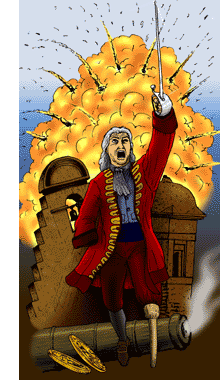|  In 1741 Cartagena de Indias would write one of the most memorable pages of its military history when on March 13th arrived to its coasts the great fleet of the Admiral Edward Vernon, excelling in quantity (186 to 123 vessels) the then famous Invincible Army of Philip II. In 1741 Cartagena de Indias would write one of the most memorable pages of its military history when on March 13th arrived to its coasts the great fleet of the Admiral Edward Vernon, excelling in quantity (186 to 123 vessels) the then famous Invincible Army of Philip II.
Vernon started with intense fire on the Castle San Luis de Bocachica, defended by the colonel Des Naux. After 16 days the Castle falls and is taken to advance towards the city.
Don Blas de Lezo, was under the command of the Viceroy Don Sebastian de Eslava who then ordered to set on fire and sink all the ships that were defending the coast on the interior of Tierrabomba. Even though Vernon managed to save one of the ships avoiding the shipwrecks to obstruct the entrance to the Bay of Cartagena de Indias.
Then he fell on the Fort Santa Cruz de Castillogrande, which was evacuated without the consent of Don Blas de Lezo, who didn't have any other choice but to sink the last ships he commanded to block the access to the Bahía de Las Animas. Again, Vernon managed to save the last ship and penetrate the bay.
When the English arrived to the Castillo San Felipe, after taking La Popa, they found a strong defense and the unforeseen detail that the stairs were very short, a big mistake: many soldiers fell under the fire of the Spaniards and had to order a retreat with many deaths.
Although the fleet went on with the bombardment from the sea, the tropical illnesses, the falls and wounded were determining to diminish the strength of the invaders and make them abandon the area after having destroyed the unprotected fortifications, burned the spanish ship they had, and bombarded the city until the last minute.
In England, the friends of Vernon had ordered the coining of medals with the figure of Blas de Lezo on his knees before Vernon and with the legend: "The Spanish pride humiliated by Admiral Vernon". The mentioned coins were subject of jokes for a long time.
The Viceroy Don Sebastián de Eslava was given the title of (Marquis of the Royal Defense of Cartagena de Indias). On the other hand, Blas de Lezo died forgotten several months after the English retreated. |



